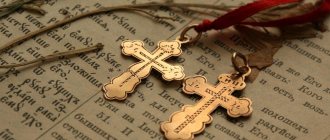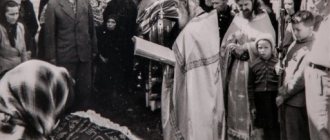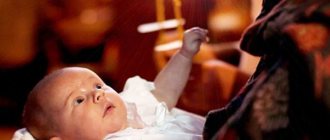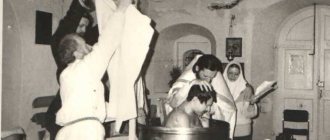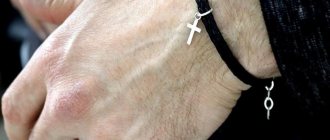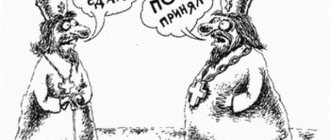Because the Jewish priests had similar clothes
Old Testament priests had special clothes. According to the Holy Scriptures, God himself commanded the prophet Moses to sew special clothes for them - “for greatness and beauty.” To do this, it was necessary to take blue, purple and crimson fabric - wool or linen, and embroider them with gold.
The clothing of the Jewish priests consisted of a chiton - an undershirt that reached to the floor, an upper robe, an ephod covering the back and chest, a belt and a turban - a turban. On top of the ephod the high priest wore a breastplate decorated with precious stones.
Through the prophet Ezekiel, God commanded the priests to use vestments only for sacred ceremonies and to remove them before leaving the temple into the outer court, changing into everyday clothes (Ezek. 44:19).
This clothing to some extent became the prototype of the modern vestments of Orthodox priests. Nowadays, they change clothes in the same way, leaving their clothes in the temple.
Pectoral cross and club
After the kamilavka, the priest’s next award is a pectoral cross, that is, worn on the chest (on the chest), over a cassock or liturgical clothing, called a phelonion. The club is a diamond-shaped plate, decorated with embroidery, church symbols, and personifies the spiritual sword against evil forces. It is worn on the chest. This award was given to the most honored archpriests.
Mace. Con. XIX century
For a long time, priests did not wear any pectoral crosses at all, just as they do not wear them to this day in the Orthodox East. The everyday eight-pointed cross was introduced into use by Tsar Nicholas II, who ordered all priests in Russia to wear it. As the historical legend tells, this happened for the following reason.
The young sovereign once approached the deacon for a blessing: as you know, they did not and do not wear crosses, and they do not have the right to bless with their hands. There was some confusion, and so that it would not be repeated, and also so that in everyday life it would be possible to distinguish deacons from priests, it was decided to grant the latter the right to wear a cross.
The award pectoral cross was established earlier, in 1798. Before the revolution, they were made of gilded silver along with a chain and exclusively in Moscow. Approximately 900 such crosses were produced per year, which were sent to dioceses, where they were awarded to the recipients.
Let us also note that if this or that priest already had a granted gold cross without decorations, then he could accept a cross with precious decorations from parishioners, but only after the Holy Synod entered with a petition to the sovereign for permission to wear it.
In addition to award crosses - ordinary and traditional, there were also memorial crosses. Thus, in memory of the war of 1812, by the manifesto of Emperor Alexander I of August 30, 1814, the clergy was given a pectoral cross with the inscription “1812.”
In a decree from the Holy Synod on February 14, 1818, in pursuance of the Tsar’s manifesto, it was decided to honor all members of the Synod and their offices, as well as all bishops, including those in retirement, with this cross.
These crosses were also awarded to the abbots of stauropegial monasteries, priests of the Kremlin Cathedrals of the Assumption and Annunciation, as well as the courtier (in the Winter Palace). However, this reward was by no means for the elite. Many priests from the white and black clergy received it - at the discretion of the diocesan bishops, to whom sets of pectoral crosses were sent.
This award was worn on a narrow ribbon of the Order of St. Vladimir. We also note that on the centenary of the Patriotic War of 1812, in 1912, priests - direct descendants of those awarded commemorative crosses or eldest in their family - received the right to wear the crosses of 1812, which were awarded to their grandfathers and great-grandfathers.
Priestly pectoral cross with decorations
After the end of the Crimean War of 1853–1856, all hierarchs and partly priests of Russia received bronze pectoral crosses from the sovereign for their feat of prayer.
On their obverse (front side) the “All-Seeing Eye” was depicted, on the reverse (back side) there was the inscription: “In You, Lord, we trust, let us not be ashamed forever.” Those priests who were in the active army received, in addition to crosses, medals on the ribbon of the Order of St. George.
THIS IS INTERESTING: What is the nationality of Nicolaus Copernicus?
The clergy who were with units brought under martial law, or in places under martial law and siege, received a medal on the St. Andrew's ribbon for the cross.
On January 24, 1913, to commemorate the 300th anniversary of the election of Mikhail Feodorovich Romanov to the kingdom, a special anniversary badge was established for the clergy. This sign was a gold or gilded four-pointed cross, covered on the front side with enamel and bordered with gold.
In addition to these and gold crosses without decorations, there were also pectoral crosses with decorations and certainly topped with a crown, which were issued by the Cabinet of His Imperial Majesty. The Holy Righteous Father John of Kronstadt, in particular, had such a cross.
According to one of the resolutions of the Moscow Patriarchate in 1962, one could be presented with a golden pectoral cross no less than five years after ordination to the priesthood.
However, this rule was not particularly adhered to, and in Soviet times, as now, it was a fairly common reward.
But, in order to somehow distinguish the recipient from the line of other persons, the award was presented either simultaneously with ordination to the priesthood, or the presentation of the cross was combined with the award of a kamilavka and legguard, the presentation of an order, or an appointment to a new place.
A whole dynasty of Tarasyev priests is well known, who served in the courtyard of the Moscow Patriarchate in Belgrade. There, from 1950 to 1974, Father Vitaly, respected by all, served as priest; His son Vasily served the priest from childhood, then, having matured, he created a choir of Orthodox and non-Orthodox youth.
The whole of Belgrade knew his father Vitaly's bell ringing system - a unique set of Yaroslavl bells. He was also known as the chairman of the charitable committee for helping the poor and elderly of his parish.
A year later, after he was ordained a priest, in 1957, Patriarch Alexy I of Moscow granted Father Vasily a golden pectoral cross and a club.
By the way, Father Vasily was awarded by Patriarch Alexy a cross with decoration and at the same time a miter. At the same time, the Serbian Patriarch Vincent allowed him to perform divine services in the miter not only in the courtyard, but also in other churches in Serbia, which was not allowed even to local archimandrites.
Patriarch of Moscow Pimen, during his visit to Yugoslavia, simultaneously with the decree appointing Father Vasily as the new rector of the metochion (October 5, 1974), granted him a cross with decorations.
Priestly pectoral cross. XIX century
The pectoral cross as a reward was given not only to Orthodox priests. At one time, even non-church people were well aware of Hewlett Johnson, the rector of Canterbury Cathedral in England, who had sincere sympathy for the USSR and later became a laureate of the Lenin Peace Prize.
In 1945, Patriarch Alexy I, during an audience in Chisty Lane, presented the rector with a pectoral cross, which he did not part with until the end of his days, wearing it on his chest.
Ten years later, Patriarch Alexy I and his closest associate, Metropolitan Nicholas of Krutitsky and Kolomna, were visited by Heinrich Held, the president of the Evangelical Church of the Rhineland of Germany, on whom a pectoral cross was also solemnly placed.
In those years we had especially warm relations with representatives of the Anglican Church. Even before the revolution, they visited our country, they visited both Moscow and the Trinity-Sergius Lavra. The Anglican priest, known to us as the children's writer Lewis Carroll, and high-ranking prelates were there. Thus, in July 1956, Archbishop of York Dr. Michael Ramsey, like his predecessors, visited the Lavra of St. Sergius and prayed in vestments at his shrine.
After the Kazan Summer Liturgy, he and other members of the Anglican Church delegation were received by His Holiness Patriarch Alexy I, who placed a golden pectoral cross on Dr. Ramsay; precious crosses were also placed on the Bishop of Derby, Dr. Rawlinson, and the Bishop of Oxford, Dr. Carpenter.
THIS IS INTERESTING: Which city is called the city of three religions
In turn, when His Holiness the Patriarch was in London eight years later, Dr. Ramsay, at the throne of Canterbury Cathedral, presented the Patriarch with one of the highest awards of the Anglican Church - the Lambeth Cross. But the “last word” still remained with our hierarch: he could not present the cross again to the Archbishop of York, so he awarded his wife the established Order of the Holy Equal-to-the-Apostles Grand Duke Vladimir, 2nd degree.
Another primate of the Anglican Church, Dr. Frederick D. Kogan, was presented with a pectoral cross on January 25, 1974 by Metropolitan Juvenaly of Tula and Belevsky (current Krutitsky and Kolomensky).
Source: https://oldhat.ru/symbol_1/85.htm
Because Jesus wore a tunic and a robe
However, we should not forget that the Lord himself wore a tunic when he was a man. According to the Gospel, this tunic was woven seamlessly, and after the crucifixion of the Savior, the Roman soldiers did not dare to cut it and decided to cast lots to find out who would get it.
The warrior who took possession of the priceless shrine, according to legend, took the tunic to Georgia, where it remained until Shah Abbas took possession of it, who presented the tunic to Tsar Mikhail Feodorovich.
Other versions speak in favor of the fact that part of Christ’s robe, that is, his outer clothing, was brought to the king, and the tunic still remains in Georgia, in the foundation of the Mtskheta Patriarchal Cathedral.
From the events it becomes clear that Christ wore a man's dress - a long, thin, white chiton, over which was worn a shorter and denser robe.
The clothes did not appear immediately
Christians did not immediately have liturgical clothes, because the Savior wore ordinary clothes, and the apostles celebrated the Eucharist in everyday attire. Nevertheless, the understanding that it was necessary to serve God in special clothes already existed: the Apostle James wore the clothes of a Jewish priest, and the Apostle John put a gold bandage on his head - the sign of the high priest.
Over time, Christ's everyday clothing became sacred, the tunic and vestments remained part of the vestments of priests, and until the 7th century, the main canon of vestments for ministers of the Orthodox Church was formed.
Each thing has its own symbol
In the attire of a priest, each item is given a separate meaning. For example, the hair shirt tunic, in which the monks-schema monks dress, symbolizes non-covetousness and during tonsure is called the “tunic of free poverty.”
Similar to the tunic, the surplice is worn by altar servers, readers and sextons; the surplice is a symbol of angelic purity and joy.
The deacon dresses in a surplice and puts on an orarion, meaning the wings of an angel - a long strip of material with crosses and embroidery “Holy, Holy, Holy.” It is believed that the orarion appeared from a towel-ubrus, which the Jews used to sign to say “Amen”.
The priest's clothes are a man's long dress down to his toes - the cassock comes in different cuts - with a wrap or with buttons. This is the only vestment that the priest can wear outside the temple. On top of the cassock they put on a cassock - a spacious black vestment with long sleeves - below the palms. The cross that priests wear over their clothes should remind them that every Christian must confess Christ before everyone.
During the Liturgy, the priest puts on a surplice, which has the same meaning as a surplice.
A phelonion or chasuble is put on the cassock - a long, wide garment without sleeves, with hard and high shoulders, which signifies loyalty to God and the scarlet robe that was put on the Savior during His suffering. It is known that the Apostle Paul already wore a veil.
The priest puts on the remaining vestments over the phelonion. These are armbands - armlets, which are fastened with laces, symbolizing the bonds of Christ; stole - a long strip of material with six crosses around the neck, symbolizing service to Christ; a belt symbolizing readiness to serve; a legguard, which is a sign of the spiritual sword - the weapon of a priest, which is a rectangular plate with a cross. It points to the Gospel and is worn in the same place where warriors previously carried a sword.
In the Russian Orthodox Church, clergy have the right to wear clothes in gold, white, red, blue, purple, black and green - depending on the service being performed and the church calendar. The symbolism of color is considered unsettled and differs in the Russian Orthodox Church in Russia and abroad.
Phelon Sakkos Surplice This
These robes, which have the general name "robes",
used by clergy during worship services.
They are divided into three categories: deacons, priests
and
bishops
(the attire of clergy who do not belong to the clergy does not fall into these categories). An interesting feature is the fact that each subsequent degree of priesthood has all the liturgical vestments of the previous one, plus those vestments that belong to their degree. That is, the priest has all the deacon’s robes and, in addition, those inherent in his rank; the bishop has all the priestly vestments (except for the phelonion, which is replaced by the sakkos) and, in addition, those assigned to his episcopal rank.
Deacon in liturgical vestments
Priest in liturgical vestments
Some of these clothes are symbols of grace-filled gifts, and without them the clergyman cannot perform divine services. Liturgical vestments
are:
1
.
For the deacon
-
cassock, bridle, surplice, orarion
;
2
.
For the priest
-
a cassock, a cassock
(during the Liturgy,
is worn
a cassock ), bridles, stole, belt, phelonion, pectoral cross;
3
.
For the bishop
-
a cassock, a cassock
(at the Liturgy, instead of a cassock -
a cassock ), armbands, epitrachelion, belt, club, sakkos
(instead of
a sakkos
there can be
a phelonion ), omophorion, panagia, cross, miter.
The clergy serve in a surplice.
The priest can perform some services without a phelonium
, and the bishop without
sakkos.
As a reward, priests are given the right to wear
a skufiya, kamilavka
or
miter
, as well as
a legguard, a club, and a cross with decorations.
Surplice
- liturgical vestments of priests and clergy.
There are different surplices
for clergy, deacon, priest and bishop.
The difference between the liturgical clothes of the lower rank of clergy - deacons - is that they serve in a cassock, over which a surplice is put on.
The surplice of a deacon (and a clergyman - an altar boy, a sexton) is a long garment, consisting of two halves, with wide sleeves, with slits from the armpits to the bottom, fastened with buttons.
The surplice
symbolizes the garment of salvation.
The priestly and bishop's surplice
are vestments called a sacristan.
Surplice
Podsnik
- liturgical vestments of a priest and bishop - long silk (less often made of other materials) clothes, waist-length, with narrow sleeves, white or yellow.
The bishop's vestment
has so-called
gammata
, or
springs -
ribbons that tighten the sleeve at the wrist.
The scales
symbolize the flow of blood from the Savior’s perforated hands.
As already mentioned, the cassock
replaces the cassock for the bishop or priest during the celebration of the Liturgy.
Podryznik
Handle
- part of the liturgical vestments of the clergy, which are trapezoidal strips of dense material with an image of a cross on their outer side, trimmed along the edges with a ribbon that has a different shade than the
arms
.
Another name for armbands is sleeves,
which means that this part of the liturgical vestment is fixed on the wrist, on the sleeve of the cassock.
The handrail
is tightened with a cord threaded through metal loops on its side edges, and the cord is tightly wrapped around the hand and held firmly to it.
The orders
symbolize God's power, strength and wisdom bestowed on the clergy to perform the Divine Sacraments.
Orar
- part of the liturgical vestment of a deacon and subdeacon - a long narrow ribbon worn by them on the left shoulder, with one end going down to the chest, the other to the back.
The orarion
belongs only to deacons and received its name from the Greek verb “oro”, which means I look, guard, observe.
However, in Latin there is a verb absolutely identical in spelling (Latin
verb “
oro
”), but meaning “to pray.”
Another meaning of the word orar is
towel, lention (from
Latin orarium).
Orar
The archdeacon and protodeacon have a double orarion,
which consists of
two connected oraria
: one is worn similarly to the deacon’s, and the second descends from the left shoulder to the right thigh, where it is connected at the ends.
Orar
symbolizes the grace-filled gifts that the deacon receives upon ordination.
The subdeacon puts on the orarion
in the shape of a cross, as a sign that he does not have the grace of a clergyman.
According to the interpretation of St. John Chrysostom, the orarion
symbolizes immaterial angelic wings in accordance with the image of angelic service in the Church, which is personified by deacons.
Stole
(
Greek
: neck) - an accessory to the liturgical vestments of a priest and bishop, which is a long ribbon (a deacon’s orarion, but as if doubled), covering the neck and descending at both ends to the chest.
It is sewn or fastened with buttons at the front and is worn over a cassock or cassock. The epitrachelion
formed from the orarion meant that the priest acquired greater grace than the deacon, giving him the right and obligation to be the celebrant of the Sacraments of the Church.
The epitrachelion
symbolizes the priest's grace-filled gifts that he receives in the Sacrament of the Priesthood.
That is why, when putting on the stole
, the prayer is read: “Blessed is God, pour out His grace on His priests, like Myrrh on the head, descending on the bard, the bard of Aaron, descending on the sweeps of his clothes” (see: Ps. 132; 2).
Epitrachelion and poruchi
Without stole
priests and bishops do not have the right to perform divine services. Only in extremely difficult circumstances can any long piece of cloth or rope, especially blessed, be used instead.
Belt
- part of the liturgical vestments of the priest and bishop, worn over the vestment and epitrachelion, is a dense, 10–15 cm wide, strip of material with trim in the form of stripes of a different shade along the edges.
in the middle of the belt
, and at its ends there are long ribbons with which it is secured at the back, on the lower back.
The belt resembles the towel with which the Savior girded when washing the feet of His disciples at the Last Supper. Symbolically, the belt
in religious use has always meant strength, strength, power, readiness to serve, which is clearly reflected in the prayer read when putting it on: “Blessed be God, gird me with strength, and make my path blameless; Place me on high” (see: Ps. 17; 33.34). It still has the same meaning today.

